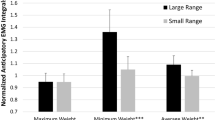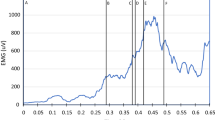Abstract
The purpose of this experiment was to examine the effects of advance knowledge on the kinematics of one-handed catching. Balls were launched from a distance of 8.4 m by a ball-projection machine with adjustable launching speed. Fifteen skilled ball catchers caught 160 balls with their preferred hand under blocked-order (4 blocks, each comprising 20 trials at 1 of 4 different ball speeds) or random-order (4 blocks, each comprising 20 trials of 4 different ball speeds) conditions. By projecting balls with different ball speeds from a fixed position, it was possible to modify the temporal constraints of the catching task. In both the blocked-order and random-order conditions, catching performance (number of catches, touches and misses) decreased with increasing temporal constraints. Analysis of successful trials indicated that this equal level of catching performance was achieved with different movement kinematics. Specifically, there was a change in movement time, latency, wrist velocity profile, and coefficient of straightness. Based on expectancy of previous trials, movement kinematics was scaled to ball speed in the blocked-order condition whereas in the random-order condition, participants exhibited a more default initial response. However, this latter mode of control was functional in that it increased the likelihood of success for the higher ball speeds while also providing participants with a larger temporal window to negotiate the unexpected temporal constraint on-line for the lowest ball speed.



Similar content being viewed by others
Notes
Ball flight times, resultant ball speeds and landing locations were evaluated in a pilot study conducted prior to the experiment. High Speed Cameras (Bassler AG, Ahrensburg, Germany) registered at 100 Hz the moment the ball left the ball machine and contacted a panel that was at 8.4 m from the ball machine (participant’s frontal plane).
References
Araujo D, Davids K, Passos P (2007) Ecological validity, representative design, and correspondence between experimental task constraints and behavioral setting: comment on Rogers, Kadar, and Costall (2005). Ecol Psychol 19:69–78
Bennett S, Davids K, Craig T (1999) The effect of temporal and informational constraints on one-handed catching performance. Res Q Exerc Sport 70:206–211
Bootsma RJ, Fayt V, Zaal FTJM, Laurent M (1997) On the information-based regulation of movement: what Wann (1996) may want to consider. J Exp Psychol Hum Percept Perform 23:1282–1289
Borysiuk Z, Sadowski J (2007) Time and spatial aspects of movement anticipation. Biology of Sport 24:285–295
Button C, Davids K, Bennett SJ, Taylor MA (2000) Mechanical perturbation of the wrist during one-handed catching. Acta Psychol 105:9–30
Button C, Davids K, Bennett SJ, Savelsbergh GJP (2002) Anticipatory responses to perturbation of co-ordination in one-handed catching. Acta Psychol 109:75–93
Daum MM, Huber S, Krist H (2007) Controlling reaching movements with predictable and unpredictable target motion in 10-year-old children and adults. Exp Brain Res 177:483–492
de Lussanet MHE, Smeets JBJ, Brenner E (2002) The relation between task history and movement strategy. Behav Brain Res 129:51–59
Dessing JC, Bullock D, Peper CE, Beek PJ (2002) Prospective control of manual interceptive actions: comparative simulations of extant and new model constructs. Neural Networks 15:163–179
Elliott D, Allard F (1985) The Utilization of Visual Feedback Information During Rapid Pointing Movements. Q J Exp Psychol Sect A Hum Exp Psychol 37:407–425
Gray R (2002a) Behavior of college baseball players in a virtual batting task. J Exp Psychol Hum Percept Perform 28:1131–1148
Gray R (2002b) “Markov at the bat”: a model of cognitive processing in baseball batters. Psychol Sci 13:542–547
Hansen S, Glazebrook CM, Anson JG, Weeks DJ, Elliott D (2006) The influence of advance information about target location and visual feedback on movement planning and execution. Can J Exp Psychol 60:200–208
Jensen JL, Thelen E, Ulrich BD (1989) Constraints on multi-joint movements—from the spontaneity of infancy to the skill of adults. Hum Mov Sci 8:393–402
Khan MA, Franks IM, Goodman D (1998) The effect of practice on the control of rapid aiming movements: evidence for an interdependency between programming and feedback processing. Q J Exp Psychol Sect A Hum Exp Psychol 51:425–444
Khan MA, Elliott D, Coull J, Chua R, Lyons J (2002) Optimal control strategies under different feedback schedules: Kinematic evidence. J Mot Behav 34:45–57
Khan MA, Mourton S, Buckolz E, Franks IM (2008) The influence of advance information on the response complexity effect in manual aiming movements. Acta Psychol 127:154–162
Lacquaniti F, Maioli C (1989) The role of preparation in tuning anticipatory and reflex responses during catching. J Neurosci 9:134–148
Laurent M, Montagne G, Savelsbergh GJP (1994) The control and coordination of one-handed catching—the effect of temporal constraints. Exp Brain Res 101:314–322
Li FX, Laurent M (1995) Intensity coupling in interceptive tasks. Studies in perception and action III, pp 191–194
Lopez-Moliner J, Field DT, Wann JP (2007) Interceptive timing: prior knowledge matters. J Vis 7:1–8
Mazyn LIN, Lenoir M, Montagne G, Savelsbergh GJP (2004) The contribution of stereo vision to one-handed catching. Exp Brain Res 157:383–390
Mazyn LIN, Montagne G, Savelsbergh GJP, Lenoir M (2006) Reorganization of catching coordination under varying temporal constraints. Mot Control 10:143–159
Mazyn LIN, Savelsbergh GJP, Montagne G, Lenoir M (2007) Planning and on-line control of catching as a function of perceptual-motor constraints. Acta Psychol 126:59–78
Michaels CF (2000) Information, perception, and action: What should ecological psychologists learn from Milner and Goodale (1995)? Ecol Psychol 12:241–258
Michaels CF, Withagen R, Jacobs DM, Zaal FTJM, Bongers RM (2001) Information, perception, and action: a reply to commentators. Ecol Psychol 13:227–244
Montagne G, Laurent M, Durey A, Bootsma R (1999) Movement reversals in ball catching. Exp Brain Res 129:87–92
Moras G, Busca B, Pena J, Rodriguez S, Vallejo L, Tous-Fajardo J, Mujika I (2008) A comparative study between serve mode and speed and its effectiveness in a high-level volleyball tournament. J Sports Med Phys Fitness 48:31–36
Nader S, Machado S, Cunha M, Portella CE, Silva JG, Velasques B, Bastos VH, Basile L, Cagy M, Piedade R, Ribeiro P (2008) Posterior parietal cortex role in a sensorimotor task performance. Arquivos Neuro Psiquiatria 66:341–343
Nitsch JR (2009) Ecological approaches to sport activity: a commentary from an action-theoretical point of view. Int J Sport Psychol 40:152–176
Norman J (2002) Two visual systems and two theories of perception: an attempt to reconcile the constructivist and ecological approaches. Behav Brain Sci 25:73
Ranganathan R, Carlton LG (2007) Perception—action coupling and anticipatory performance in baseball batting. J Mot Behav 39:369–380
Regan D (1997) Visual factors in hitting and catching. J Sports Sci 15:533–558
Rosenbaum DA (1980) Human movement initiation—specification of arm, direction, and extent. J Exp Psychol Gen 109:444–474
Savelsbergh GJP, Whiting HTA, Bootsma RJ (1991) Grasping Tau. J Exp Psychol Hum Percept Perform 17:315–322
Savelsbergh GJP, Whiting HTA, Pijpers JR, Van Santvoord AAM (1993) The visual guidance of catching. Exp Brain Res 93:148–156
Senot P, Zago M, Lacquaniti F, McIntyre J (2005) Anticipating the effects of gravity when intercepting moving objects: differentiating up and down based on nonvisual cues. J Neurophysiol 94:4471–4480
Song JH, Nakayama K (2007) Automatic adjustment of visuomotor readiness. J Vis 7:1–9
Tresilian JR, Plooy AM, Marinovic W (2009) Manual interception of moving targets in two dimensions: performance and space-time accuracy. Brain Res 1250:202–217
van der Kamp J, Savelsbergh G, Smeets J (1997) Multiple information sources in interceptive timing. Hum Mov Sci 16:787–821
van Donkelaar P, Lee RG, Gellman RS (1992) Control strategies in directing the hand to moving targets. Exp Brain Res 91:151–161
Werner SL, Suri M, Guido JA, Meister K, Jones DG (2008) Relationships between ball velocity and throwing mechanics in collegiate baseball pitchers. J Shoulder Elbow Surg 17:905–908
Zago M, Bosco G, Maffei V, Iosa M, Ivanenko YP, Lacquaniti F (2004) Internal models of target motion: expected dynamics overrides measured kinematics in timing manual interceptions. J Neurophysiol 91:1620–1634
Zago M, McIntyre J, Senot P, Lacquaniti F (2009) Visuo-motor coordination and internal models for object interception. Exp Brain Res 192:571–604
Author information
Authors and Affiliations
Corresponding author
Rights and permissions
About this article
Cite this article
Tijtgat, P., Bennett, S.J., Savelsbergh, G.J.P. et al. Advance knowledge effects on kinematics of one-handed catching. Exp Brain Res 201, 875–884 (2010). https://doi.org/10.1007/s00221-009-2102-0
Received:
Accepted:
Published:
Issue Date:
DOI: https://doi.org/10.1007/s00221-009-2102-0




